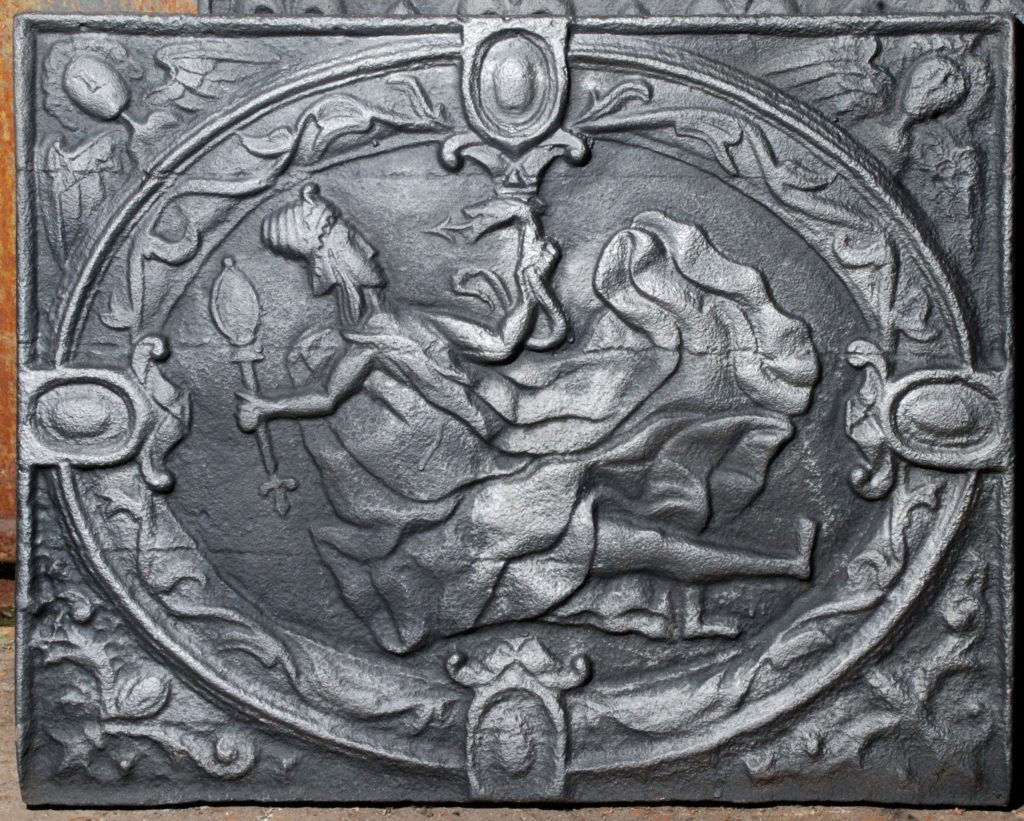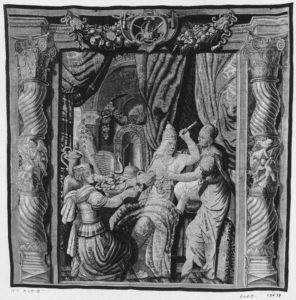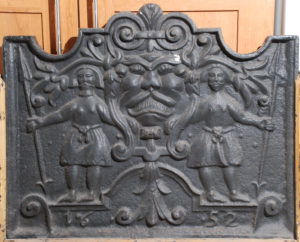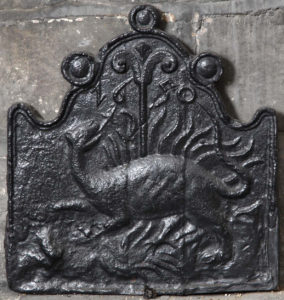
As English firebacks go this is an unusual one. The central figure appears to be lying on a couch, although the couch itself is absent. The snake held in the subject’s left hand suggests that this is Cleopatra, queen of Egypt, about to commit suicide by allowing the snake – traditionally an asp – to poison her with its bite. In her right hand is either a sceptre indicating her royalty, or a hand mirror alluding to her legendary beauty. The image is within an elliptical border decorated with plant tendrils. In the spandrels above the border are angels, while in those below are simple foliate designs. The figuration is naïve and the anatomical detail of Cleopatra’s arms and legs is unnatural. The faces of the angels are crude. Whoever designed the pattern for this fireback was not a skilled artist. It is not a large casting; at 59cm wide it is less than two feet across, but the pattern from which the mould was formed was evidently constructed from five boards battened together, four distinct horizontal lines on the fireback’s surface indicating where they abutted.



So what was the inspiration for this design? In the late-16th and early-17th centuries there was a growth in print-making in the Low Countries, with engravers such as Hendrik Goltzius and Jan Sadeler producing sets of prints of paintings by Mannerist artists. Such seems to have been the case with the picture of Cleopatra. Although I have not been able to track down the original source, the closest images I have been able to find that might also have been inspired by the scene also reproduced on the fireback are three tapestries. The first is in a set of tapestries of the story of Antony and Cleopatra now in the collection of the Indianapolis Museum of Art in the United States. It shows her seated with a small sceptre in her hand and a snake emerging from a basket held by a handmaid that is entwining itself around her arm. It dates from the early- to mid-17th century. Although the composition on the tapestry is not identical to that on the fireback, one can see how the design of the fireback may been derived from the same source that influenced the design of the tapestry. A second tapestry, in the collection of the Patrimonio Nacional in Spain, shows a very similar scene. This one is thought to have been part of a set made for the Swedish royal court in the 1640s. They were both based on a design by Karel van Mander the younger (1579-1623), a Flemish artist and tapestry maker. The third tapestry, which is in private hands is very similar to the other two and from the tapestry workshop of Pieter de Cracht in about 1650. Quite clearly it derived its inspiration from the same source
The dates of the tapestries suggest that the fireback was probably made towards the end of the first half of the 17th century. The naïve style has parallels with other firebacks of the period, particularly in the depiction of faces. And features that compare with other elements of the design of the Cleopatra fireback, such as the small details on the four oval buttons around the border surrounding the figure of the queen, can be seen on other firebacks, suggesting they may have been the work of the same craftsperson whose initials, IM, are to be seen on some firebacks. This fireback is an early example of a design for an English fireback being derived from a continental source. It was a practice that was to be employed to a much greater extent at the very end of the 17th century when English fireback designs aped Germany styles made originally for the Dutch market.

